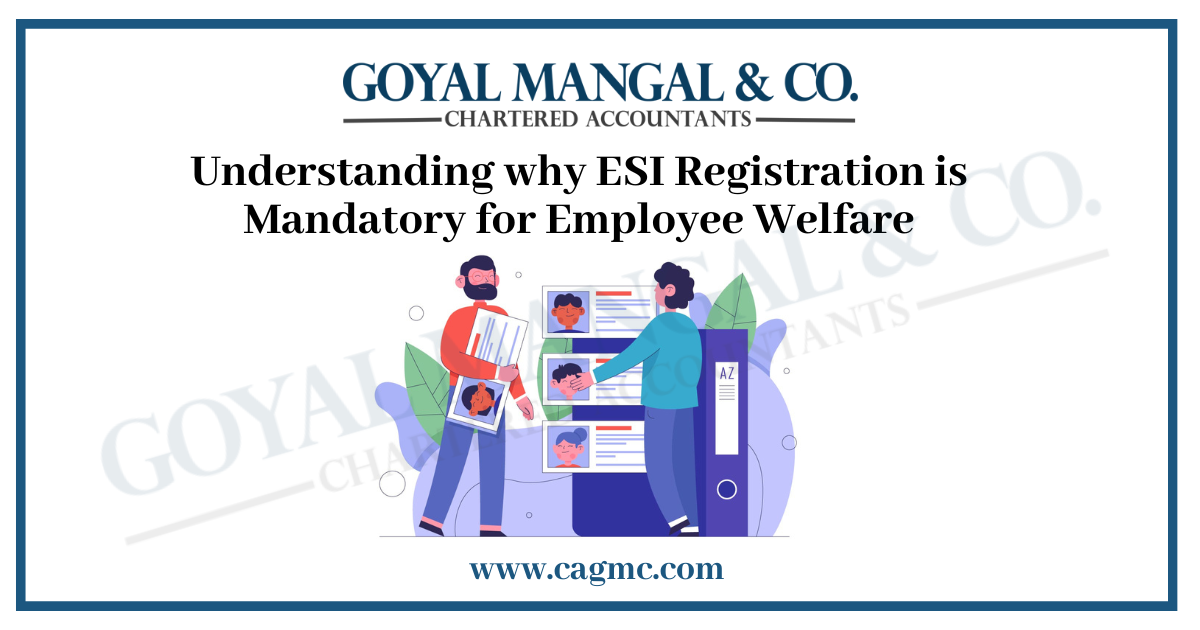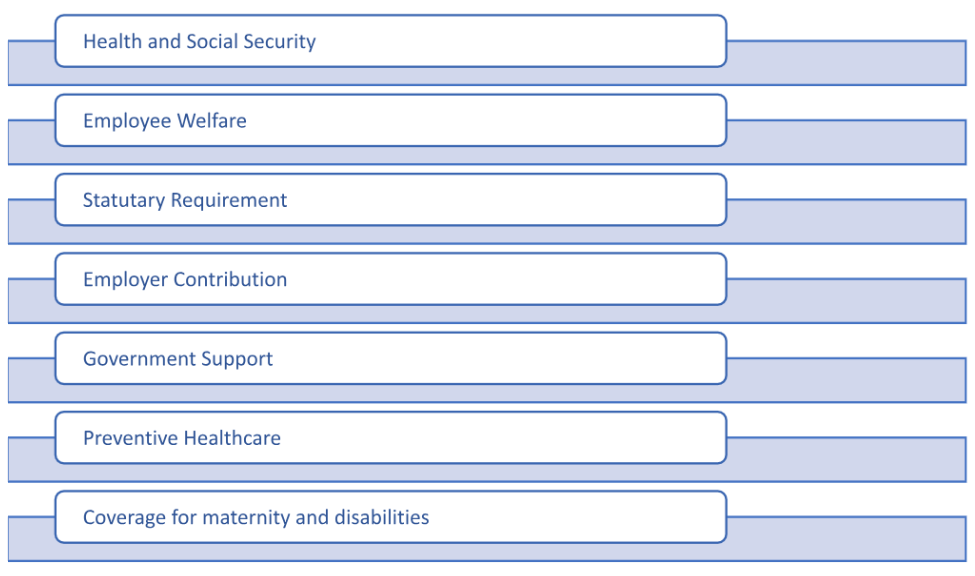
In today’s dynamic, well-being and employee security have emerged as supreme priorities for businesses and governments. One of the significant aspects of protecting employee welfare is the mandatory registration under the Employee’s State Insurance (ESI) scheme. Implementation under the Employee State Insurance Act, 1948 provides the social security and health insurance scheme. It plays a crucial role in offering financial protection and medical benefits to workers during times of adversity. In this article, we offer the importance of ESI registration and why ESI Registration is mandatory.
| Table of Content |
Overview of ESI Registration
ESI registration for Employee Welfare refers to the process by which an employer or establishment in India enrols itself with the Employee’s State Insurance Corporation (ESIC) to avail of the benefits of the Employee’s State Insurance (ESI) scheme. The ESI scheme is a social security and health insurance program established under the Employees’ State Insurance Act, 1948. Its main objective is to provide financial and medical assistance to employees during times of sickness, maternity, temporary or permanent disability, and in the event of their death due to employment-related injuries.
Under the ESI scheme, both employees and employers make contributions towards the insurance fund. The employer deducts a certain percentage of the employee’s wages as an ESI contribution and adds a matching amount from the employer’s funds. This contribution is then deposited with the ESIC to provide various benefits to the insured employees.
ESI registration ensures that employees have access to adequate medical care and financial support during times of need, promoting their overall welfare and creating a healthier and more secure workforce. It also imposes certain legal obligations on employers to comply with the ESI Act’s provisions. Such as maintaining records, and submitting regular contributions and returns to the ESIC.
What is covered under ESI Registration?
Areas covered under ESI Registration are-
- Private Educational Institutions
- Shops
- Road Motor Transport
- Hotels or Restaurants
- Cinemas
- Newspaper establishments
Eligibility Criteria for ESI Registration
Here is the eligibility for ESI registration for Employee Welfare:
- Employee Count: To be eligible for ESI registration, an establishment must have a minimum of 10 (in some states, it could be 20) employees. This threshold includes both permanent and contractual employees.
- Wage Limit: The ESI Act, 1948 (hereinafter referred to as the said act) applies to employees earning a specific amount of wages per month. Employees with a monthly wage of up to Rs. 21,000 are covered under the scheme.
- Nature of Work: The said Act, applies to certain categories of establishments engaged in specific industries or businesses.
- Geographical Location: The said Act’s applicability is location-specific. It is mandatory for establishments falling within the defined geographical areas where the Act is in force.
- Previous Coverage: If an establishment was covered under the said Act in the past and the number of employees falls below the minimum threshold, it may still be required to continue the coverage.
- Voluntary Coverage: Establishments with employee strength below the mandated limit can also opt for voluntary ESI registration. This enables them to avail benefits for their employees voluntarily.
Documents required for ESI Registration
Here is a general list of documents typically needed for ESI registration:
- Registration Application Form
- Certificate of Incorporation
- Memorandum and Article of Association (for companies)
- Pan Card
- Aadhaar Card
- Bank Account Details
- Employee Details
- Business Address Proof
- Proof of Identity and Address of the Employer
- Registration Certificate
ESI Registration Process
The ESI registration process in India involves several steps. Here is a general outline of the registration process:
- Determine Eligibility: Verify if your establishment meets the eligibility criteria for ESI registration. Ensure that you have at least 10 (or 20 in some states) employees and that the wages of your employees are within the prescribed limit (up to Rs. 21,000 per month as of my last update).
- Gather Documents: Collect all the required documents for ESI registration, as mentioned above.
- Online Registration: The ESI registration process is typically done online through the ESIC portal. Visit the ESIC website and click on the “Online Registration” link.
- Fill Application Form: Fill out the ESI registration application form with accurate information about your establishment, employees, and other required details.
- Upload Documents: Scan and upload all the necessary documents, such as the certificate of incorporation, PAN card, employee details, address proof, etc., as part of the online application.
- Submit Application: After completing the form and uploading the documents, apply online.
- Verification and Processing: Once the application is submitted, the ESIC authorities will verify the information and documents provided. They may also conduct a physical inspection of your establishment.
- ESI Code Allotment: Upon successful verification, the ESIC will issue an ESI registration number (commonly known as the ESI code) for your establishment.
- Display ESI Notice: After receiving the ESI code, you are required to display the ESI notice at a conspicuous place in your establishment, informing employees about their rights and benefits under the ESI scheme.
- Contribution Payment: Once registered, you must start contributing to the ESI scheme. The employer’s contribution is a percentage of the employee’s wages, and the same amount is deducted from the employee’s salary.
- Periodic Compliance: After registration, the establishment must comply with the ESI Act’s provisions, maintain necessary records, and submit regular contributions and returns as required.
Why ESI Registration is mandatory?
Here are the reasons why ESI registration for Employee Welfare is mandatory:

- Health and Social Security: ESI provides health insurance coverage to employees and their dependents. It ensures that employees have access to medical facilities and treatment without financial burden during times of illness or injury.
- Employee Welfare: ESI helps in promoting the welfare of employees, providing them with a safety net and a sense of security, which can lead to better employee retention and satisfaction.
- Statutory Requirement: The said Act makes it obligatory for employers to register their establishments under the scheme if they meet the eligibility criteria. Non-compliance can result in penalties and legal consequences.
- Employer Contribution: Employers are required to contribute a certain percentage of their employees’ wages towards the ESI scheme. This contribution goes into a pool that funds the medical benefits and administrative expenses of the scheme.
- Government Support: The government also contributes to the ESI scheme, helping to provide better and more comprehensive coverage to insured employees.
- Preventive Healthcare: The ESI scheme emphasizes preventive healthcare measures to improve the overall health and productivity of the workforce.
- Coverage for Maternity and Disabilities: ESI extends coverage to maternity benefits, which is crucial in supporting women employees during their pregnancy and childbirth. It also provides disability benefits in case of temporary or permanent disablement due to employment-related injuries.
End Notes
In conclusion, we can say that the requirement for ESI registration rises from the government’s commitment to promote employee welfare and making a secure work environment. The ESI registration fosters a sense of security among employees, improving job satisfaction and retention rates. In essence, ESI registration represents a collective effort towards building a socially responsible and empathetic society, where the health and security of the workforce are at the forefront of economic progress.


